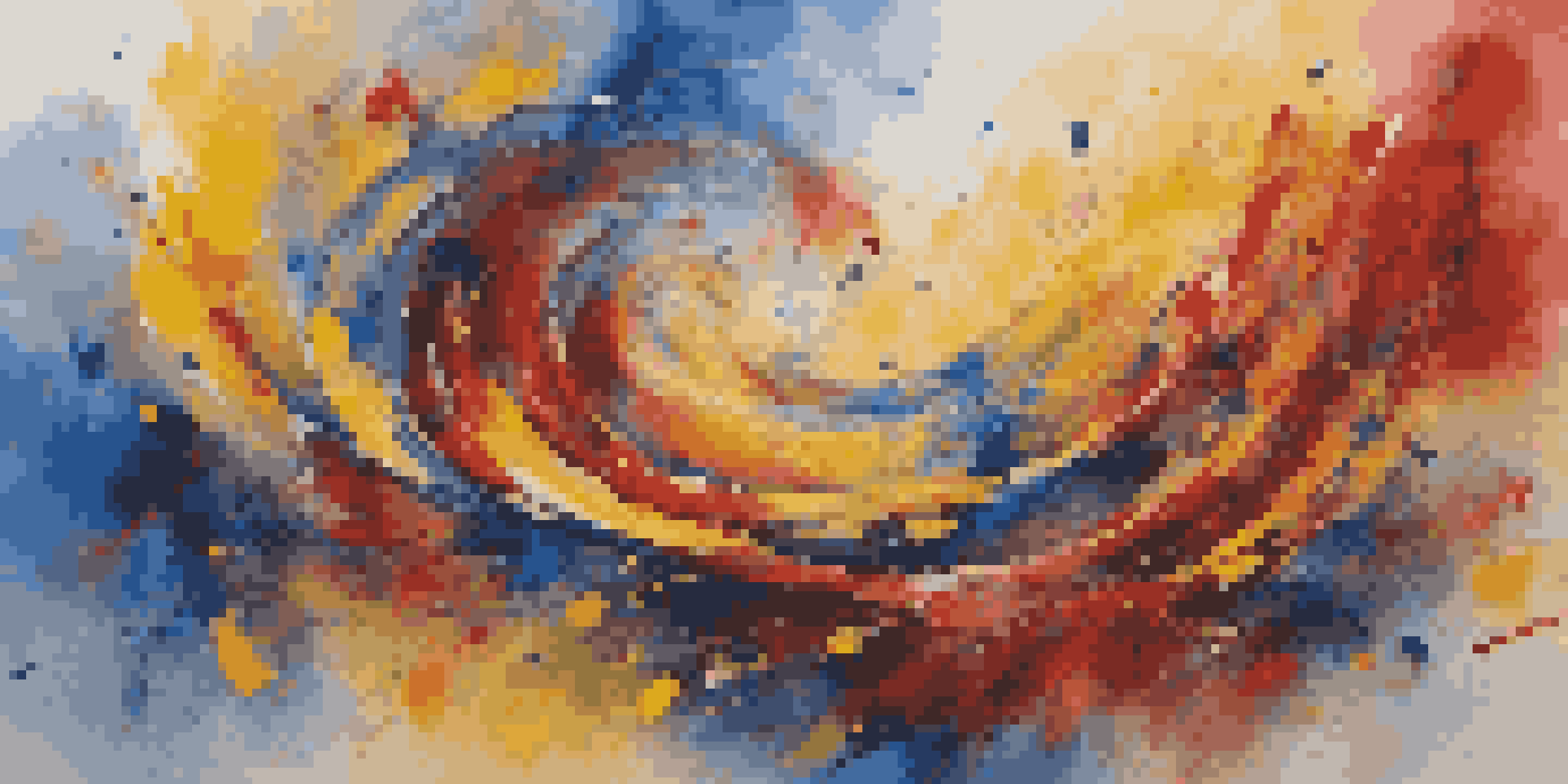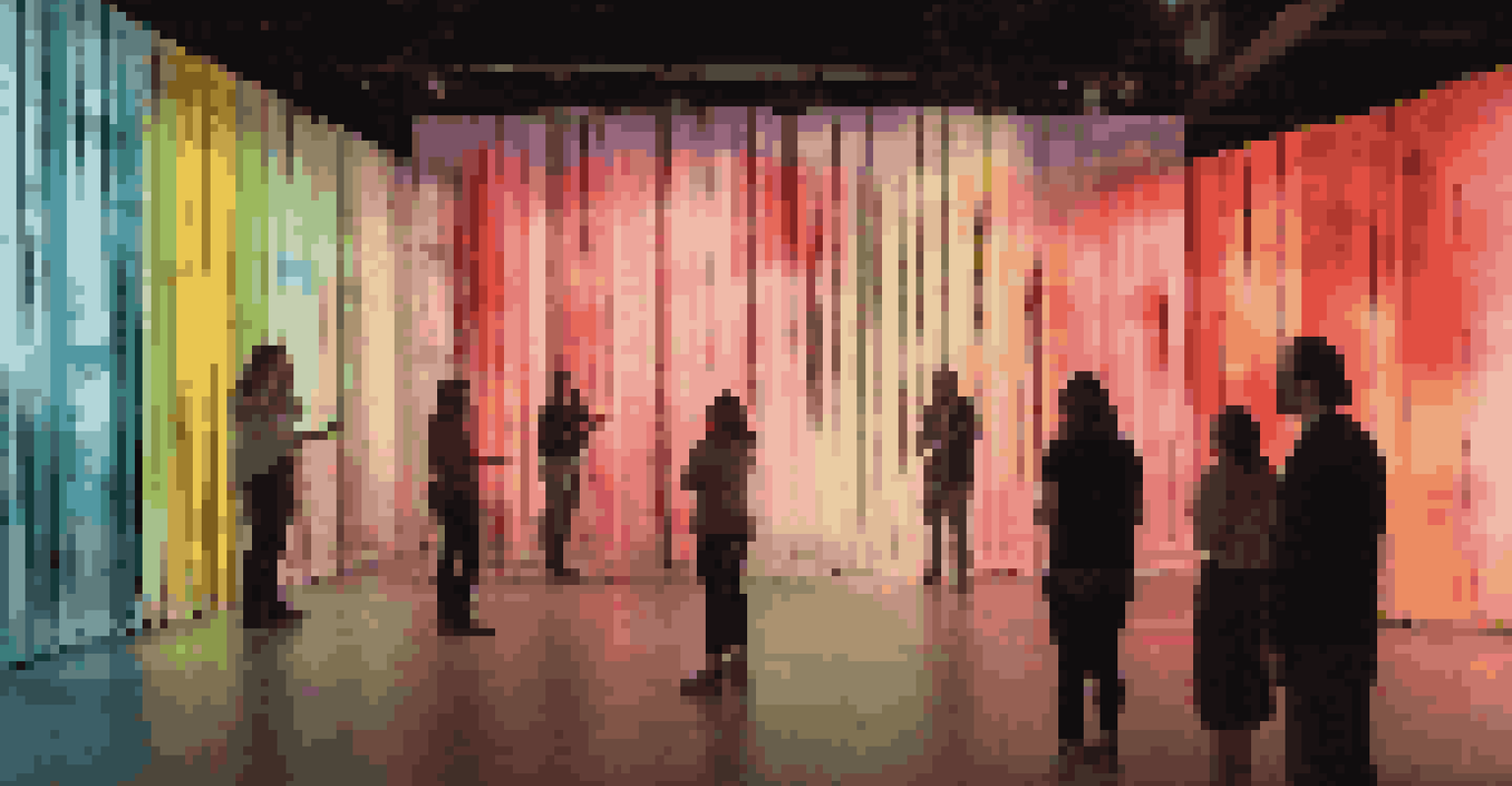The Influence of Music on Visual Art: A Cross-Disciplinary Study

Understanding the Connection Between Music and Art
At first glance, music and visual art may seem like two distinct worlds. However, both are powerful forms of expression that communicate emotions and ideas. Just as a painter uses colors and shapes to convey feelings, musicians use notes and rhythms to create a mood. This shared language allows for a dynamic interplay where one medium can inspire the other.
Every artist dips his brush in his own soul, and paints his own nature into his pictures.
Consider how a painting might evoke a certain genre of music; a vibrant, abstract piece might remind you of a lively jazz tune, while a somber landscape could call to mind a melancholy ballad. This cross-pollination enriches both art forms, allowing artists to draw on a broader palette of inspiration. As we explore this connection, it’s essential to recognize the nuances of how music influences the visual arts.
Throughout history, artists have often turned to music as a source of inspiration. From classical composers influencing the works of the Impressionists to modern artists incorporating sound installations in galleries, the synergy between these disciplines is undeniable. This shared journey not only fosters creativity but also invites audiences to engage with both art forms in a new light.
Historical Context: Music's Role in Art Evolution
To appreciate the influence of music on visual art, we can look back at various art movements. For instance, during the Romantic period, artists like Caspar David Friedrich sought to evoke emotion akin to the stirring compositions of composers such as Chopin. The emotional depth found in both music and visual art during this era showcases a profound interrelationship that shaped cultural expressions.

Similarly, the Avant-Garde movement of the early 20th century saw artists like Wassily Kandinsky explicitly drawing connections between visual and auditory experiences. Kandinsky even believed that colors could elicit sounds, creating a synesthetic experience that resonated with his audience. This exploration illustrates how music not only influenced individual artists but also served as a catalyst for entire movements.
Art and Music: A Dynamic Duo
Both music and visual art share a powerful connection, inspiring and influencing each other to enhance emotional expression.
As we trace the threads of history, we find that artists often collaborated with musicians, leading to groundbreaking works that bridged these disciplines. For example, the Ballets Russes, which combined music, dance, and visual art, transformed the performance landscape, showing how interdisciplinary collaboration can yield innovative results. Understanding this historical context helps us grasp the ongoing dialogue between music and visual art.
The Emotional Impact of Music on Art Creation
Music has a unique ability to evoke emotions, and this emotional resonance often seeps into visual art. Many artists listen to music while creating, allowing it to influence their brushstrokes, color choices, and overall composition. For example, an artist might paint a vibrant, energetic scene while listening to upbeat pop music, capturing the essence of joy and movement.
Music is an outburst of the soul.
Conversely, music can also evoke feelings of solitude or introspection, leading to more subdued artworks. A painter might choose a palette of muted colors while listening to a slow, haunting melody, reflecting a mood of contemplation. This emotional interplay highlights how music can serve as both a muse and a mirror for the artist’s emotions.
Additionally, the rhythmic structure of music can influence the pacing and flow of visual art. Just like a musical composition has a tempo, a painting can have a rhythm that guides the viewer's eye. This parallel enhances the viewer's experience, inviting them to feel the music through the visual narrative presented by the artist.
Case Studies: Artists Inspired by Music
One notable example of an artist profoundly influenced by music is Vincent van Gogh. His work, 'Starry Night,' is often associated with the music of his time, and it is said that he was inspired by the sounds of nature and the music he loved. The swirling skies and vibrant colors reflect a rhythm and energy reminiscent of the melodies that played in his mind, illustrating the deep connection between his art and the music that surrounded him.
Another example is the contemporary artist Olafur Eliasson, who integrates sound and visual installations to create immersive experiences. His work often incorporates music as part of the sensory experience, allowing viewers to engage with both sound and sight. This cross-disciplinary approach highlights how artists today continue to explore and celebrate the influence of music on their creative processes.
Historical Influence on Art
Throughout history, music has played a significant role in shaping various art movements, from Romanticism to Avant-Garde.
These case studies serve as powerful reminders of the diverse ways in which music can inspire visual art. By examining the connections between specific artworks and the music that inspired them, we gain deeper insights into the creative process and the collaborative spirit that thrives across artistic disciplines.
The Role of Sound in Visual Art Installations
In recent years, sound art has gained popularity, blurring the lines between music and visual art. Installations that incorporate sound invite viewers to experience art in a multi-sensory way, enhancing their engagement with the work. For instance, artists like Janet Cardiff create audio walks that guide viewers through spaces, combining storytelling with soundscapes that transport them to another world.
These immersive experiences demonstrate how sound can alter the perception of visual art. A viewer might walk through a gallery and find that the background music enhances their emotional response to the artwork, making it more impactful. This synergy encourages artists to experiment with how sound interacts with visual elements, leading to innovative installations.
As sound art continues to evolve, it challenges traditional notions of what constitutes art. By incorporating music and sound into visual experiences, artists invite audiences to rethink their understanding of both disciplines, fostering a richer appreciation for the interplay between music and visual art.
Contemporary Artists Melding Music and Visual Art
Today, many contemporary artists actively blend music and visual art, creating new hybrid forms. Take, for example, the work of Bill Viola, who is known for his video installations that incorporate sound and music to evoke deep emotional responses. His pieces remind us that the boundaries between art forms are increasingly porous, allowing for creative experimentation.
Another artist, Jennifer Allora and Guillermo Calzadilla, create installations that incorporate live performances, merging visual art with musical elements. Their collaborative approach not only enriches the viewing experience but also highlights the significance of collaboration in the creative process, where music and visual art coexist harmoniously.
Future of Art and Sound Integration
With advancements in technology, the interaction between music and visual art is set to evolve, offering innovative and immersive experiences.
These contemporary practices emphasize the significance of music in shaping the evolution of visual art. By embracing cross-disciplinary approaches, artists can create works that resonate on multiple levels, inviting audiences to explore the connections between different forms of expression.
The Future of Music and Visual Art Interactions
As we look to the future, the relationship between music and visual art is likely to evolve even further. The rise of technology has opened new avenues for artists to explore, such as virtual reality and augmented reality experiences that combine sound and visuals in unprecedented ways. This technological advancement promises exciting possibilities for immersive art experiences that engage the senses like never before.
Furthermore, as global cultures continue to intersect, we can expect an even richer tapestry of influences between music and visual art. Artists from diverse backgrounds will bring their unique perspectives, resulting in innovative works that reflect a blend of traditions and contemporary practices. This cross-cultural exchange will undoubtedly inspire fresh collaborations and creative dialogues.

Ultimately, the future of music and visual art interactions is bright, with endless possibilities for exploration and innovation. By embracing new technologies and diverse influences, artists can continue to push the boundaries of creativity, offering audiences unique experiences that celebrate the profound connection between these two powerful forms of expression.